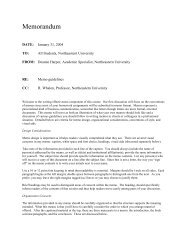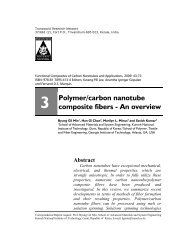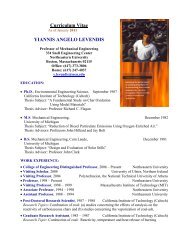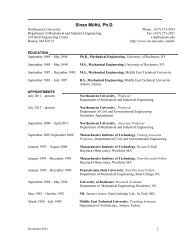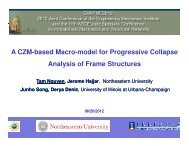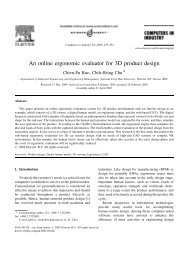Create successful ePaper yourself
Turn your PDF publications into a flip-book with our unique Google optimized e-Paper software.
200 L. Pallarés, J.F. <strong>Hajjar</strong> / Journal of Constructional Steel Research 66 (2010) 198–212<br />
static <strong>and</strong> large-amplitude cyclic (i.e., seismic) forces, without<br />
steel profile sheeting or a metal deck. The results given in<br />
this work are applicable to composite elements including steel<br />
reinforced concrete columns (SRCs) or concrete-filled tubes<br />
(CFTs), concrete-encased <strong>and</strong> concrete-filled beams, boundary<br />
elements of composite wall systems, composite connections,<br />
composite column base conditions, <strong>and</strong> related forms of composite<br />
construction. In this work, the limit states of failure in the steel<br />
anchor <strong>and</strong> concrete pryout are accounted for in the assessments<br />
made <strong>and</strong> the recommendations put forward. As discussed below,<br />
the limit state of concrete breakout, as defined for stud anchors in<br />
shear in ACI 318 Appendix D [2], is assumed not to be a governing<br />
limit state for these forms of composite construction. An extensive<br />
set of test results of headed steel anchors in configurations<br />
applicable to composite construction has been collected <strong>and</strong><br />
analyzed relative to the design provisions put forward in AISC<br />
[30], EC-4 (2004) [32], ACI 318-08 Appendix D [2], <strong>and</strong> PCI 6th<br />
Edition (PCI, 2004) [6]. Recommendations <strong>and</strong> design guidelines<br />
are then proposed for headed steel anchors subjected to shear force<br />
in composite construction. Approximately 27% of the test results<br />
utilized in this work include lightweight concrete so as to get a<br />
comprehensive set of test results for composite construction.<br />
3. Monotonic behavior of headed studs subjected to shear<br />
forces<br />
A comprehensive collection of headed steel anchors tests under<br />
static loads may be found in [4]. The present work is based mainly<br />
on that collection with added test data found in the literature,<br />
including [40,41,12,42,39,43]. In total, 391 tests were considered<br />
when examining the monotonic behavior of headed steel anchors.<br />
There are three main failures that may occur in a headed stud<br />
anchor for composite structures, namely: steel failure, weld failure,<br />
<strong>and</strong> failure of the concrete surrounding the headed stud. In this<br />
work, weld failure is included as a steel failure, since the distinction<br />
between weld <strong>and</strong> steel failure is often difficult to ascertain in the<br />
experiments.<br />
Of the 391 tests on headed steel studs, 114 tests were classified<br />
as concrete failure <strong>and</strong> 202 were classified as steel failure. The rest<br />
of the failures were not reported by the author or were classified as<br />
mixed failure. Within this data set, 286 tests used normal-weight<br />
concrete <strong>and</strong> 105 of the tests used lightweight concrete.<br />
Schematics of the tests are presented in Table 2. Generally,<br />
there are three types of tests. The first type is a push-out test<br />
[e.g., [7,15], etc.]. The second type is conducted horizontally with<br />
edge conditions far away from the tested steel anchor [e.g., [4,35]].<br />
The third type takes into account special conditions such as in<br />
infill walls (e.g., [39]). The push-out test usually simulates well<br />
the conditions in composite structures, producing pryout or steel<br />
failure of the anchor between the steel <strong>and</strong> concrete.<br />
The collected tests have been used to assess the approaches<br />
proposed by AISC [30], EC-4 (2004) [32], PCI 6th Edition [6], <strong>and</strong><br />
ACI 318-08 [2]. All four of the provisions use a general form<br />
of φvCvAsFun to predict the strength of the headed stud when<br />
the failure occurs in the steel shank, where φv is the resistance<br />
factor, Cv is a reduction factor of the strength, As is the crosssectional<br />
area of the headed stud <strong>and</strong> Fu is the specified (nominal)<br />
minimum tensile strength of the headed stud anchor, <strong>and</strong> n is the<br />
number of studs. The coefficient values from the three st<strong>and</strong>ards<br />
are presented in Table 3.<br />
The general form of the formulas to compute the nominal<br />
strength of an individual headed stud anchor when failure is in<br />
the concrete, as provided by ACI 318-08 [2] <strong>and</strong> PCI 6th Edition<br />
[6], is φvCvRvn. These formulas are based on the 5% fractile; that<br />
is, the formulas are developed such that there is a 90% confidence<br />
level that over 95% of the failures occur above the calculated limit<br />
state value for an individual anchor [48]. The ACI 318-08 average<br />
strength formulas are given in [49]. The PCI 6th Edition average<br />
strength formulas are given in [4].<br />
The most likely concrete failure modes that may occur in composite<br />
construction given by ACI 318-08 Appendix D are breakout<br />
<strong>and</strong> pryout. Breakout is a type of failure occurring when free edge<br />
conditions govern the failure. In these cases, failure planes form a<br />
volume of concrete surrounding the anchor, separating this concrete<br />
from the member. In contrast, pryout failure happens in a local<br />
area surrounding the anchor corresponding to a formation of a<br />
concrete spall in the direction perpendicular to the applied shear<br />
force. It is likely that breakout failure rarely occurs in composite<br />
structures <strong>and</strong> is assumed in this work not to be a governing limit<br />
state since there are not appropriate failure planes for front-edge<br />
or side-edge breakout in the vast majority of composite members,<br />
particularly if typical reinforcement detailing is used. The tests reported<br />
by Ollgaard et al. [15] are representative of the fact that<br />
pryout, following the terminology of ACI 318-08, or ‘‘in the field’’<br />
following the terminology of PCI 6th Edition, is the concrete failure<br />
mode that is most likely to occur in composite structures.<br />
ACI 318-08 proposes a formula to compute the pryout failure<br />
(Vcp) based on the basic concrete breakout strength in tension<br />
(Nb), which necessitates the computation of several intermediate<br />
quantities. However, PCI 6th Edition provides a direct formula to<br />
compute the pryout failure when the ratio hef /d is less than 4.5.<br />
This assumes that when the ratio hef /d is larger than 4.5, the most<br />
likely failure is in the steel shank. The formulas from ACI 318-08<br />
<strong>and</strong> PCI 6th Edition to compute the pryout failure are summarized<br />
in Table 3.<br />
AISC [30] provides a formula to compute the shear strength in<br />
composite components other than composite beams. This formula<br />
is an adaptation of the formula for headed steel anchors in<br />
composite beams proposed by Ollgaard et al. [15], who calibrated<br />
it by adjusting different models to the 48 test results developed<br />
in their research. Currently, reliability of the headed steel anchor<br />
against premature failure is taken into account as a part of the<br />
design of the composite component, such as a composite column;<br />
hence, the headed steel anchor strength typically does not have its<br />
own resistance factor in AISC [30]. The resulting formula (Equation<br />
I2-12 in [30]) is presented in Table 1 (as [15]). Eurocode-4 (2004), in<br />
contrast, proposes a similar formula to compute the shear strength<br />
in composite members, but this formula is affected by partial safety<br />
factors (Table 3) that provide more conservative results than [30].<br />
4. Comparison of AISC 2005, EC-4, ACI 318-08, AND PCI 6th<br />
Edition<br />
The current formula for the nominal shear strength of a<br />
steel anchor � (other than in composite �beams) in AISC [30]<br />
(0.5As f ′<br />
c<br />
Ec < AsFu) <strong>and</strong> EC-4 [32] (Cv0.5As f ′<br />
c<br />
Ecm) was computed<br />
for each of the 391 tests (using the minimum value of the steel<br />
<strong>and</strong> concrete failure modes) <strong>and</strong> compared to the experimentally<br />
obtained load. In these formulas, measured values of Ec are used, or<br />
in cases where the measured values are not provide, Ec is calculated<br />
per ACI 318-08 [2] using measured properties of the concrete<br />
strength. Ecm is calculated per [50] using measured properties of<br />
the concrete strength. Measured Fu values were not provided by<br />
the authors in a very small number of cases. In these cases, for this<br />
study, the specified (nominal) values of Fu given by the authors<br />
were used.<br />
The results are shown in Fig. 1(a, e). 1 The ratio of experimental<br />
strength to predicted strength, Vtest/Vpredicted, was less than 1 for<br />
235 of the 391 tests for AISC 2005, indicating that the formula is<br />
1 The legend for the markers in the figures is identified in the list of notation.



